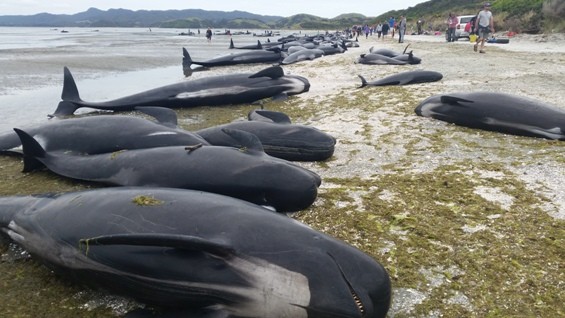By Ana Verayo, | February 12, 2017

Stranded pilot whales at Farewell Spit, New Zealand
More than 650 whales stranded themselves on a beach in New Zealand on Friday and now, rescuers were able to save hundreds of them. About 200 of these pilot whales were able to swim back out to see and return home, Sunday, February 12.
These massive marine mammals were found at the Farewell Spit in South Island, in two separate mass beach strandings. Unfortunately, 350 of them were already dead and 20 of them were euthanized by local environmental authorities.
Like Us on Facebook
To date, some 100 whales were able to refloat by volunteers and more than 200 were able to swim away without human assistance, according to conservationists. Farmers and tourists along with locals in the hundreds worked hard for days to douse the creatures with buckets of water to keep them cool while trying to refloat them.
According to spokesman for the New Zealand Department of Conservation Herb Christophers, everyone hopes that strandings are over but some scientists and researchers suggest that it is still possible that some of the animals would return to the beach. The first group of whales was discovered early Friday with more than 400 of them and many already dead or dying.
According to local reports, there were sounds of splashing water and blowholes clearing and sighing. The youngest whales were the worst sound since they were crying and there is nothing you can do at the time.
On Saturday, volunteers were able to refloat the surviving whales however, a second mass stranding occurred just hours later. According to spokesman of the New Zealand Department of Conservation, Andrew Lamason, they confirmed that there is another separate whale pod since they already tagged all the refloated whales. The first group all had tags while the newly arrived group did not.
In this massive effort, volunteers were able to form human chains in the water to try to keep the whales away from the shore. The volunteers proceeded with caution as local officials warned that one of the whales possessed bite marks that appear to come from a shark.
Soon enough, local officials will need more help from the government to dispose hundreds of carcasses. Officials suggest tethering them together and floating them on shallow waters to decompose.
This is not the first time that Farewell Spit saw a massive whale stranding. Scientists say that this sand formation that arches over the Tasman Sea can even cause to entrap some marine creatures along its coastline. Its sloping beaches can also make it hard for whales to navigate away from this formation when they arrive too close.
Current theories why whales strand themselves involve chasing prey too near the beach shores, protecting a sick member of the whale pod, escaping from a predator or even solar storms that hit the Earth's magnetosphere that can disturb their inner compasses.
This is also the third largest whale stranding of New Zealand where the largest one was in 1918 when an estimated 1,000 pilot whales went ashore in Chatham Islands.
-
Use of Coronavirus Pandemic Drones Raises Privacy Concerns: Drones Spread Fear, Local Officials Say

-
Coronavirus Hampers The Delivery Of Lockheed Martin F-35 Stealth Fighters For 2020

-
Instagram Speeds Up Plans to Add Account Memorialization Feature Due to COVID-19 Deaths

-
NASA: Perseverance Plans to Bring 'Mars Rock' to Earth in 2031

-
600 Dead And 3,000 In The Hospital as Iranians Believed Drinking High-Concentrations of Alcohol Can Cure The Coronavirus

-
600 Dead And 3,000 In The Hospital as Iranians Believed Drinking High-Concentrations of Alcohol Can Cure The Coronavirus

-
COVID-19: Doctors, Nurses Use Virtual Reality to Learn New Skills in Treating Coronavirus Patients







